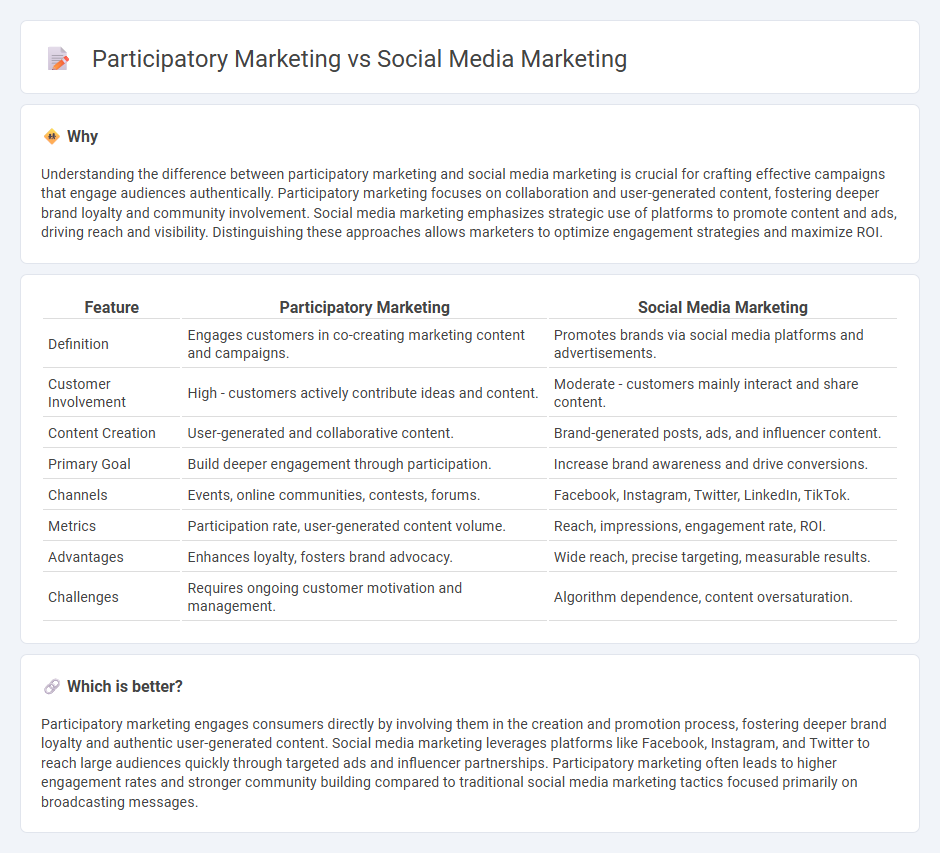
Participatory marketing emphasizes active consumer involvement in brand promotion, fostering community engagement and co-creation of content. Social media marketing leverages platforms like Facebook, Instagram, and Twitter to reach broad audiences through targeted ads and influencer partnerships. Explore the distinct strategies and benefits of both approaches to enhance your marketing efforts.
Why it is important
Understanding the difference between participatory marketing and social media marketing is crucial for crafting effective campaigns that engage audiences authentically. Participatory marketing focuses on collaboration and user-generated content, fostering deeper brand loyalty and community involvement. Social media marketing emphasizes strategic use of platforms to promote content and ads, driving reach and visibility. Distinguishing these approaches allows marketers to optimize engagement strategies and maximize ROI.
Comparison Table
| Feature | Participatory Marketing | Social Media Marketing |
|---|---|---|
| Definition | Engages customers in co-creating marketing content and campaigns. | Promotes brands via social media platforms and advertisements. |
| Customer Involvement | High - customers actively contribute ideas and content. | Moderate - customers mainly interact and share content. |
| Content Creation | User-generated and collaborative content. | Brand-generated posts, ads, and influencer content. |
| Primary Goal | Build deeper engagement through participation. | Increase brand awareness and drive conversions. |
| Channels | Events, online communities, contests, forums. | Facebook, Instagram, Twitter, LinkedIn, TikTok. |
| Metrics | Participation rate, user-generated content volume. | Reach, impressions, engagement rate, ROI. |
| Advantages | Enhances loyalty, fosters brand advocacy. | Wide reach, precise targeting, measurable results. |
| Challenges | Requires ongoing customer motivation and management. | Algorithm dependence, content oversaturation. |
Which is better?
Participatory marketing engages consumers directly by involving them in the creation and promotion process, fostering deeper brand loyalty and authentic user-generated content. Social media marketing leverages platforms like Facebook, Instagram, and Twitter to reach large audiences quickly through targeted ads and influencer partnerships. Participatory marketing often leads to higher engagement rates and stronger community building compared to traditional social media marketing tactics focused primarily on broadcasting messages.
Connection
Participatory marketing leverages customer engagement by encouraging user-generated content and active brand interaction, which is amplified through social media marketing platforms. Social media fosters real-time communication and community building, creating a dynamic environment where participatory marketing thrives. The synergy between these strategies enhances brand loyalty and drives organic reach by empowering consumers to co-create marketing narratives.
Key Terms
**Social Media Marketing:**
Social media marketing leverages platforms like Facebook, Instagram, and Twitter to promote brands, engage audiences, and drive traffic through targeted advertisements and content strategies. It focuses on analyzing metrics such as engagement rates, click-through rates, and conversion tracking to optimize campaigns for maximum ROI. Explore the key differences and advantages of social media marketing to enhance your digital strategy.
Content Strategy
Social media marketing leverages targeted content distribution to increase brand visibility and engagement across platforms like Facebook, Instagram, and LinkedIn, emphasizing scheduled posts, paid ads, and influencer partnerships. Participatory marketing centers on co-creating content with the audience through interactive campaigns, user-generated content, and real-time feedback to foster community involvement and authentic brand connections. Explore in-depth strategies and examples to enhance your content approach effectively.
Engagement Metrics
Social media marketing leverages platforms like Facebook, Instagram, and Twitter to increase brand visibility and measure performance through engagement metrics such as likes, shares, comments, and click-through rates. Participatory marketing emphasizes active consumer involvement, driving engagement through user-generated content, interactive campaigns, and community-building activities that foster deeper connections and brand loyalty. Explore how combining these strategies can maximize engagement metrics to boost your marketing ROI.
Source and External Links
What is social media marketing (SMM)? - Productsup - Social media marketing is the use of platforms like Instagram, Facebook, TikTok, YouTube, and Pinterest to connect with your audience, build brands, increase sales, and drive website traffic by posting engaging content and fostering community.
Social media marketing: What it is and how to build your strategy - Social media marketing promotes brands and products through content creation, customer interaction, and influencer collaborations; it emphasizes dynamic, short-form videos and influencer edutainment to maximize engagement in 2025.
What is a social media marketing strategy? - Building a successful social media marketing strategy involves defining clear goals and KPIs, optimizing influencer marketing, leveraging AI and automation for content and analytics, and proving ROI through data-driven reports.
 dowidth.com
dowidth.com